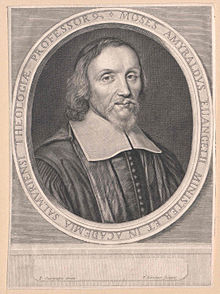Moses Amyraut
This article needs additional citations for verification. (February 2010) |

Moïse Amyraut, Latin Moyses Amyraldus (September 1596 – 8 January 1664), in English texts often Moses Amyraut, was a French
Life
Amyraut was born at Bourgueil, in the valley of the Changeon in the province of Anjou. His father was a lawyer, and, preparing Moses for the same profession, sent him, on the completion of his study of the humanities at Orléans, to the university of Poitiers.
At the university he took the degree of licentiate (BA) of
He moved to the
Amyraut had left the choice to the synod. He was appointed to Saumur in 1633, and to the professor's chair along with the pastorate. On the occasion of his inauguration he maintained for thesis De Sacerdotio Christi. His co-professors were Louis Cappel and Josué de la Place, who also were Cameron's pupils and lifelong friends, who collaborated in the Theses Salmurienses, a collection of theses propounded by candidates in theology prefaced by the inaugural addresses of the three professors. Amyraut soon gave to French Protestantism a new direction.
In 1631 he published his Traité des religions; and from this year onward he was a foremost man in the church. Chosen to represent the provincial synod of Anjou, Touraine and Maine at the 1631 National Synod of Charenton, he was appointed as orator to present to the king The Copy of their Complaints and Grievances for the Infractions and Violations of the Edict of Nantes.
Previous deputies had addressed the king on their bent knees, whereas the representatives of the Catholics had been permitted to stand. Amyraut consented to be orator only if the assembly authorized him to stand. There was intense resistance.
Amyraut had as many as a hundred students in attendance upon his lectures. One of these was
Seventeenth century opponents
There were a number of theologians who defended Calvinistic orthodoxy against Amyraut and Saumur, including Friedrich Spanheim (1600–1649) and Francis Turretin (1623–1687). Ultimately, the Helvetic Consensus was drafted to counteract the theology of Saumur and Amyraldism.
See also
Notes
- ^ Iustitia Dei: A History Of The Christian Doctrine Of Justification - Page 269 Alister E. McGrath - 2005 "The importance of this threefold scheme derives from its adoption by Moses Amyraut as the basis of his distinctive theology.211 Amyraut's 'hypothetical universalism' and his doctrine of the triple covenant between God and humanity is ..."
- ^ Hubert Cunliffe-Jones A History of Christian Doctrine - Page 436 2006 "The appointment of John Cameron, a peripatetic Scottish scholar, to be a professor in the Academy in 1618 introduced a stimulating teacher to the scene,1 and when in 1626 his pupil, Moses Amyraut (Amyraldus), was called to be a minister ..."
- ^ "Report of the Committee to Study Republication: The Orthodox Presbyterian Church". opc.org. Retrieved 2022-11-09.
- ^ Chisholm, Hugh, ed. (1911). . Encyclopædia Britannica. Vol. 1 (11th ed.). Cambridge University Press. pp. 901–902.
References
- Edm. Saigey, Moses Amyraut, sa vie et ses écrits (1849)
- Alex. Schweizer in Tüb. theol. Jahrbb., 1852, pp. 41 ff. 155 ff., Protestant.
- Central-Dogmen (1854 ff.), ii. 225 ff., and in Herzog-Hauck, Realencyklopädie
- Pierre Bayle, s.v.; Biog. Univ., s.v.
- John Quick, Synodicon in Gallia Reformata, pp. 352–357
- John Quick (MS). Icones Sacrae Gallicanae: Life of Cameron
- This article incorporates text from a publication now in the public domain: Chisholm, Hugh, ed. (1911). "Amyraut, Moses". Encyclopædia Britannica. Vol. 1 (11th ed.). Cambridge University Press. pp. 901–902.
